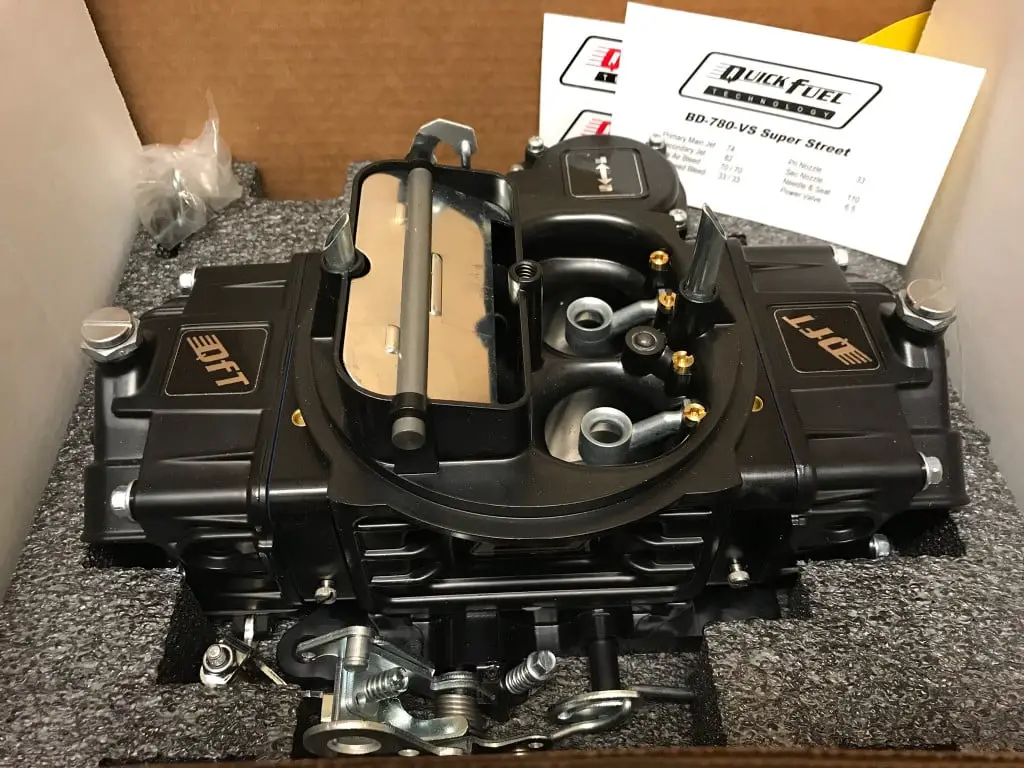Swapping a Carburetor for EFI in Your Bullnose Truck: The How, the Why, and the Options

If you’ve been working on your Bullnose truck (1980-1986), chances are you’ve thought about upgrading from a carburetor to fuel injection (EFI). Maybe it’s because you’re tired of cold starts, or you’re after better performance and fuel economy. Whatever the reason, the carburetor-to-EFI swap is one of the best mods you can do for a classic truck like a Bullnose. But before you dive in, it’s essential to understand what’s involved and how to approach it.
This article will walk you through what carburetors and EFI systems are, the pros and cons of swapping, and the options available for an EFI conversion. Let’s get started.
Carburetor vs. EFI: The Basics
Carburetors have been around since the early days of internal combustion engines. They work by mixing air and fuel mechanically, relying on vacuum pressure and simple physics to deliver the right air-fuel ratio. Carburetors were standard equipment in cars and trucks for decades, but they do have their quirks. They can be finicky in extreme temperatures, prone to flooding, and require regular adjustments to keep them running well.
On the other hand, EFI (Electronic Fuel Injection) is a much more precise system that uses sensors and an electronic control unit (ECU) to monitor and adjust the air-fuel mixture on the fly. This gives you better control, improved efficiency, and easier starts. While EFI became standard in vehicles by the mid-80s, it was a bit later for trucks. That’s why many Bullnose trucks still came with carburetors.
A Brief History: Ford and the Move to EFI
Ford began transitioning from carburetors to EFI in the early 80s, with passenger cars leading the way. Trucks followed later, with EFI becoming more common toward the late 80s. The 302 and 351 Windsor engines saw a lot of these transitions. For Bullnose owners, the move from carbureted to EFI is more than just an upgrade—it’s a step toward modernizing your classic truck while keeping its heart and soul intact.
Why Swap from Carburetor to EFI?
There are several solid reasons to swap to EFI, and while it’s not an overnight job, the benefits can make it more than worthwhile.
Pros of Swapping to EFI:
- Better Fuel Efficiency: EFI systems precisely control the air-fuel mixture, leading to better fuel economy compared to the older, less efficient carburetors. This is especially noticeable on long drives or when towing.
- Easier Cold Starts: If you live in a cold climate or your truck sits for long periods, you know carburetors can be a pain on cold mornings. EFI eliminates most of these issues by automatically adjusting the air-fuel mix for cold starts.
- More Power and Torque: By optimizing fuel delivery, EFI can help you squeeze more performance out of your engine. You’ll see a noticeable increase in both power and throttle response.
- Less Maintenance: Carburetors need constant tuning, adjusting jets, and cleaning out clogs, especially if the truck sits for a while. EFI systems, once installed, are much more “set it and forget it.”
- Improved Driveability: EFI systems offer smoother operation, especially during acceleration. You won’t have to worry about bogging down or stumbling during hard acceleration.
Cons of Swapping to EFI:
- Cost: An EFI conversion isn’t cheap. Even if you pull parts from a donor vehicle, you’ll still spend money on components like the fuel system and wiring harnesses. Aftermarket systems can run over $1,500 for a full kit.
- Complexity: While a carburetor is mostly mechanical, EFI involves sensors, wiring, and computers. It’s more complex and can be intimidating if you’re not familiar with electronics.
- Fuel System Overhaul: EFI requires higher fuel pressure, meaning you’ll need to swap out the fuel pump, add a return line if your truck doesn’t have one, and upgrade the fuel lines.
- Loss of Classic Engine Bay Look: For those of us who love the simplicity and nostalgic feel of a muscle car engine, swapping to EFI does change the look under the hood. The mechanical charm of a carburetor, with its fuel lines and throttle linkage, is replaced by sensors, wires, and a more modern appearance. While some aftermarket EFI systems, like the Holley Sniper, keep a carburetor-like design, the aesthetic shift can be a downside if you’re after that classic look.
Options for Your EFI Conversion
Now that you know why it’s worth swapping, let’s talk about the how. There are two main paths to take when converting your Bullnose from a carburetor to EFI: using a donor vehicle or buying an aftermarket EFI system.
Donor Vehicle EFI Systems
If you’re on a budget, finding a donor vehicle might be your best bet. The good news is that Ford trucks from the late 80s to mid-90s are excellent candidates for this. If you have access to a truck with a 302 or 351W engine from that era, you can pull the ECU, wiring harness, fuel injectors, and sensors from it. The most common donor vehicles include:
- 1994-1996 Ford F-150 or Bronco: These trucks had EFI systems on both 302 and 351 Windsor engines. The ECU and wiring harness from these trucks are highly sought after for conversions.
- 1987-1995 Ford F-Series: These models also offer suitable EFI systems, though make sure you’re grabbing components that match your engine size.
When pulling from a donor vehicle, make sure to grab the following:
- ECU (Engine Control Unit)
- Wiring harness
- Throttle body
- Intake manifold (if needed)
- Fuel injectors
- Oxygen sensors, throttle position sensor, mass air flow (MAF) sensor
While a donor system can save you some money, remember that it might still require work to integrate it into your truck, including custom wiring and possibly tuning.
Aftermarket EFI Systems
For those looking for a simpler, more modern solution, aftermarket EFI systems like the Holley Sniper or FiTech Go EFI are popular choices. These systems come as nearly all-inclusive kits, making the swap much more straightforward, even if you’re new to EFI.
- Holley Sniper EFI: This is one of the most popular systems for classic trucks. It offers a throttle body injection setup that looks similar to a carburetor and even bolts onto the same intake manifold. The Sniper system comes with its own ECU, sensors, and wiring harness, making installation a bit more plug-and-play. One of the biggest advantages is its self-learning capability—after installation, it adjusts itself based on driving conditions, so you don’t need to spend time tuning.
- FiTech Go EFI: FiTech offers a similar system to the Holley Sniper, with different models depending on your engine’s horsepower needs. It’s a cost-effective option that also provides self-tuning, meaning you don’t need to mess with much once it’s installed.
- FAST EZ-EFI: Another solid choice in the throttle body EFI arena. The FAST EZ-EFI offers easy installation and compatibility with many classic vehicles, including Bullnose trucks.
Fuel System Upgrades for EFI
When you switch from carburetor to EFI, upgrading your fuel system is non-negotiable. Carbureted systems operate at around 4-6 psi, while EFI systems need anywhere from 40-60 psi. Here’s what you’ll need to address:
Fuel Pump:
You’ll need a high-pressure electric fuel pump designed specifically for EFI. Depending on your setup, you can choose between an in-tank or inline pump. In-tank pumps generally offer better reliability and cooling, but they’re harder to install. Inline pumps are easier to install but tend to be noisier and less durable.
Fuel Lines:
With higher fuel pressure, you’ll also need to upgrade to fuel lines capable of handling EFI pressures. Many recommend using 3/8-inch lines for both supply and return. Steel braided or rubber EFI-rated hoses are both solid choices, depending on your preference and budget.
Return Line:
If your Bullnose doesn’t have a return line, you’ll need to add one. EFI systems require a return line to send unused fuel back to the tank, which helps maintain the proper fuel pressure. You can either add a new return line or use a fuel tank with provisions for one.
Fuel Pressure Regulator:
Don’t forget the fuel pressure regulator. EFI systems need a stable fuel pressure, and aftermarket regulators are available in both adjustable and fixed-pressure options. Most setups will run best around 40-45 psi.
Tuning and Diagnostics: Getting Your EFI Dialed In
Once your EFI system is installed, you’ll need to tune it for optimal performance. The good news is that many aftermarket systems, like the Holley Sniper, come with self-tuning capabilities, meaning they can automatically adjust based on your driving habits. But for those who want to take a more hands-on approach or have custom performance goals, there are options for more precise tuning.
OBD-II Diagnostics:
If you’re using a donor vehicle’s system, it likely uses OBD-II for diagnostics. Investing in an OBD-II scanner allows you to troubleshoot issues like faulty sensors, incorrect air-fuel ratios, or misfires. These scanners plug directly into your ECU and can give you real-time data on your engine’s performance.
Aftermarket Tuning Software:
For those using aftermarket EFI, many kits come with their own tuning software. Systems like the Holley Sniper allow you to adjust parameters like idle speed, timing, and fuel delivery. For folks chasing maximum performance, this can make a noticeable difference, especially if you’ve got a custom-built engine.
Legal and Emissions Considerations
If you live in a state with strict emissions laws, making sure your EFI system keeps your truck street-legal is key. Here are some things to keep in mind:
Catalytic Converters:
If your truck originally came with a catalytic converter, you’ll need to keep it in place. EFI systems typically run cleaner than carburetors, but removing emissions equipment can still cause problems if your state requires emissions testing.
Oxygen Sensors:
To stay emissions-compliant, you’ll need to install oxygen sensors in your exhaust system. These sensors help the ECU adjust the air-fuel mixture for efficient combustion and lower emissions. Make sure the placement of these sensors matches your new exhaust setup, especially if you’re upgrading headers or exhaust systems as part of your build.
Cost Breakdown and Budget Planning
Swapping from carburetor to EFI isn’t just about finding parts—it’s about planning for costs. Here’s a rough breakdown of expenses to keep in mind:
Donor EFI Conversion:
- Donor parts (ECU, sensors, wiring harness): $300-$700
- Fuel pump: $100-$300
- Fuel lines and fittings: $100-$200
- Tuning software or scanner: $50-$200
Aftermarket EFI System:
- Holley Sniper EFI or similar: $1,200-$1,600
- Fuel pump and lines: $200-$400
- Installation and tuning (if done at a shop): $500-$1,000
Final Thoughts
Swapping from a carburetor to EFI on a Bullnose truck is a fantastic way to modernize your ride, giving it the reliability, performance, and fuel efficiency of a newer truck while still maintaining the classic look and feel we all love. While the swap isn’t cheap or simple, the long-term benefits, especially if you drive your truck regularly, make it a worthwhile investment.
Whether you go the donor vehicle route or opt for a shiny new Holley Sniper, just remember: the key to success with any EFI swap is planning. Understand what your engine needs, gather all your parts before diving in, and don’t be afraid to reach out to the Bullnose community for help if you hit a snag.

If you want more specific information on Bullnose Ford Trucks, check out my YouTube Channel!
For more information on Bullnose Fords, you can check out the BullnoseFord SubReddit or Gary’s Garagemahal. Both are excellent resources.